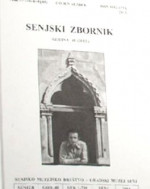Rasadničarstvo senjskog Kraljevskog nadzorništva – inspektorata
The transplanting operations of Senj’s royal supervisory – inspectorate
Author(s): Vice IvančevićSubject(s): Regional Geography, Environmental Geography, Local History / Microhistory
Published by: Senjsko muzejsko društvo i Gradski muzej Senj
Keywords: Nursery; transplantation production; seed production; Royal inspectorate for afforestation of karst areas; Inspectorate for the afforestation of karst; barren land and regulation of torrents in Senj;
Summary/Abstract: The transplantation and seed growing supervisory-inspectorate is the oldest in Croatia, but also of the wider area. The first seedlings were produced in the nursery of "Sv. Mihovil" in 1879 using seeds obtained from other sources. Meanwhile in 1895 black pine cones began to becollected in local cultures due to the further processing in the seedbed of Sv. Mihovil. In this way quality seeds of well-known provenance were obtained. For 64 years of uninterrupted work the supervisory-inspectorate conducted sowing in nurseries over 2.54 hectares or 1.49 of cultivated land with an annual average of 230 kg of seeds (70% deciduous and 30% conifer). The average annual production was 1,300,000 seedlings (93% conifer and 7% deciduous) with a dominant presence of black pine. Besides afforestation of the karst seedlings of various types of fruit were produced for the free distribution to the local population, the biological improvement of torrents, sericulture and horticulture. The search for new forms of production of Senj’s transplanting operations was primarily in the container production of seedlings. The successful results of Senj’stransplantation and seedling operations have significantly influenced the development of our forestry, and notably the afforestation of karst. Economic conditions and new technology led to the abolition of Senj’s nurseries and seedbeds in the 1970s. Due to the achieved results and the positive effect on the development of our transplantation and seeding operations and general forestry, it would be desirable to turn the derelict buildings such as the first nursery of Sv. Mihovil and the seedbed, into monuments of technical culture in the domain of forestry. In this way the gratitude for many generations of foresters would be expressed and the contribution to the valorisation of the significant achievements of our green profession in national and international frameworks would be complete.
Journal: Senjski zbornik - prilozi za geografiju, etnologiju, gospodarstvo, povijest i kulturu
- Issue Year: 40/2013
- Issue No: 1
- Page Range: 631-646
- Page Count: 16
- Language: Croatian

